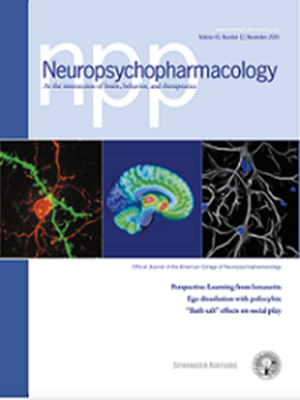Longitudinal associations between white matter integrity, early life adversities, and treatment response following cognitive-behavioral therapy in depression
IF 6.6
1区 医学
Q1 NEUROSCIENCES
引用次数: 0
Abstract
Cognitive-behavioral therapy (CBT) is a primary treatment for depression. Although previous research has underscored the significant roles of white matter (WM) alterations and maladaptive parenting in depression risk, their associations with CBT response remain largely unknown. This longitudinal study investigated the interplay of WM integrity changes over time, treatment response, and parenting style in patients with depression. Diffusion-tensor-imaging and clinical data were assessed in n = 65 (55% female) patients with depression before and after 20 CBT sessions and n = 65 (68% female) healthy controls (HC) in a naturalistic design. Linear-mixed-effect models compared changes in fractional anisotropy (FA) between groups and tested associations between FA changes and symptom changes. It was investigated whether parenting style predicts depressive symptoms at follow-up and whether FA changes mediate this association. Patients showed differential FA changes over time in the corpus callosum and corona radiata compared to HC (ptfce-FWE = 0.008). Increases in FA in the corpus callosum, corona radiata and superior longitudinal fasciculus were linked to symptom improvement after CBT in patients (ptfce-FWE = 0.023). High parental care (pFDR = 0.010) and low maternal overprotection (pFDR = 0.001) predicted fewer depressive symptoms at follow-up. The association between maternal overprotection and depressive symptoms at follow-up was mediated by FA changes (pFDR = 0.044). Robustness checks—controlling for outliers, non-linear age effects, clinical characteristics, and patient subgroups—supported these results. Overall, patients with depression show changes in WM integrity following CBT, which are linked to treatment response. The results highlight the significance of early life adversities and related microstructural changes in the effectiveness of CBT for treating depression.

抑郁症认知行为治疗后白质完整性、早期生活逆境和治疗反应之间的纵向关联。
认知行为疗法(CBT)是抑郁症的主要治疗方法。尽管先前的研究强调了白质(WM)改变和不适应的养育方式在抑郁症风险中的重要作用,但它们与CBT反应的关系在很大程度上仍然未知。这项纵向研究调查了抑郁症患者WM完整性随时间变化、治疗反应和父母教养方式的相互作用。采用自然设计,对65例(55%为女性)抑郁症患者和65例(68%为女性)健康对照(HC)在20次CBT治疗前后的弥散张量成像和临床数据进行评估。线性混合效应模型比较各组间分数各向异性(FA)的变化,并检验FA变化与症状变化之间的关系。研究了父母教养方式是否能预测随访时的抑郁症状,以及FA变化是否介导了这种关联。与HC相比,患者胼胝体和辐射冠随着时间的推移出现了不同的FA变化(ptfce-FWE = 0.008)。胼胝体、放射冠和上纵束FA的增加与CBT后患者症状的改善有关(ptfce-FWE = 0.023)。高亲代关爱(pFDR = 0.010)和低母亲过度保护(pFDR = 0.001)预测随访时抑郁症状较少。母亲过度保护与随访时抑郁症状的关系由FA变化介导(pFDR = 0.044)。稳健性检查——控制异常值、非线性年龄效应、临床特征和患者亚组——支持这些结果。总体而言,抑郁症患者在CBT后表现出WM完整性的变化,这与治疗反应有关。这些结果强调了早期生活逆境和相关微观结构变化对CBT治疗抑郁症的有效性的重要性。
本文章由计算机程序翻译,如有差异,请以英文原文为准。
求助全文
约1分钟内获得全文
求助全文
来源期刊

Neuropsychopharmacology
医学-精神病学
CiteScore
15.00
自引率
2.60%
发文量
240
审稿时长
2 months
期刊介绍:
Neuropsychopharmacology is a reputable international scientific journal that serves as the official publication of the American College of Neuropsychopharmacology (ACNP). The journal's primary focus is on research that enhances our knowledge of the brain and behavior, with a particular emphasis on the molecular, cellular, physiological, and psychological aspects of substances that affect the central nervous system (CNS). It also aims to identify new molecular targets for the development of future drugs.
The journal prioritizes original research reports, but it also welcomes mini-reviews and perspectives, which are often solicited by the editorial office. These types of articles provide valuable insights and syntheses of current research trends and future directions in the field of neuroscience and pharmacology.
 求助内容:
求助内容: 应助结果提醒方式:
应助结果提醒方式:


